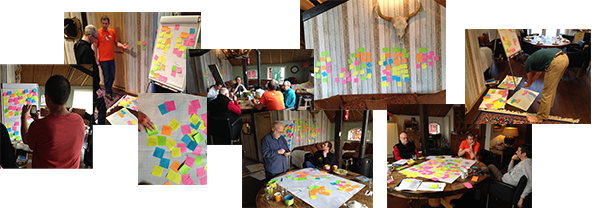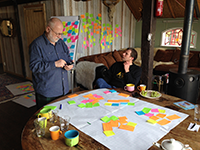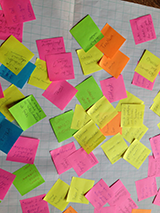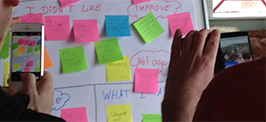The first EduPLoP is over and it was a great experience! It was friendly, highly productive and very creative! Our goal was to mine and write educational patterns, focusing on good assessment. In only three full days we have captured hundreds of experiences, started writing 24 patterns (using Google docs for collaborative writing), and identified another 11 patterns we want to write very soon. This will probably lead to 4-5 papers containing educational patterns.
One of the productive factors was the THE RIGHT PLACE. We chose a place in the Netherlands far away from the next village but with a beautiful area around. Hence, we had enough time for writing, discussing, outlining etc. without any distraction. Looking out of the window was relaxing (the storm quite chilling) and inspiring (to seek for the quality without a name). Cooking together and playing games was great for community building and intense discussions.
I was really amazed how well one important tool worked: STICKY NOTES. We had them everywhere (at the wall, the table, the flipchart), and we used them for many things: writing down expectations, educational forces, pattern ideas, examples, retrospections…
What worked out nicely was the use of large sheets of paper. We put those on the table to brainstorm good assessment strategies as a base for our later patterns. This process was inspired by Takashi Iba’s workshops on pattern mining. The large paper sheets made it possible to move whole topics or views from the table to the ground and vice versa. It was just amazing how much space our ideas literally occupied in the house!
What I like most about sticky notes:
- Everyone can use them – simplicity at its best!
- Re-arranging them is very quick.
- Notes can overlap, making information very dense.
- Spatial arrangements can be used for many meanings (relations, groups, headlines…).
- A block of sticky notes can always lay around, inviting you to write or sketch.
- Everyone can write at any time and many people can write at the same time.
Using paper sheets as backgrounds allowed us to
- Draw boundaries around groups
- Add headlines to sections
- Move groups of sticky notes around
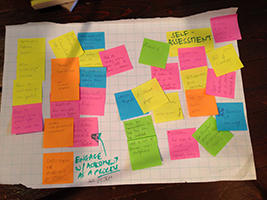
What I didn’t like (as compared to digital notes):
- We all made our photos of the sticky note walls. But do we really use them?
- To keep all notes, we copied them into Google Docs documents by typing manually. So we got all the text blocks but lost the structure. (Oh, and it did take some time to type…)
- Rearranging sticky notes means to loose old states. When you use digital tools such as SMART Meeting Pro or Lino it you can duplicate a page or board in order to save the current state. This lets you explore alternatives and return to previous layouts of sticky notes.
Well, I love sticky notes. So… we will have some thoughts on digital sticky note in the upcoming posts ![]()
I have uploaded my COINS2015 presentation on “Collaboration Tools and Patterns for Creative Thinking” to slideshare.
You can also access the short paper I submitted to the conference here.
Idea quota is an attempt to generate many ideas – quantity is king! I have first read about this method in Edward DeBono’s classic book on lateral thinking, but it is also frequently mentioned in other collections on creative thinking, for example in Michael Michalko’s Thinkertoys.
For EuroPLoP 2015 I am currently working on some new patterns for idea generation and Idea Quota is one of them. This is an excerpt of my first draft:
It is easy to come up with some ideas using Brainstorming, Idea Combination, Provocations, or any of the other techniques to find new ideas. But the ideas that come into mind at first very often are the obvious solutions or copies of existing approaches. These are hardly the ones that lead to innovation.
We are tempted to stop searching for new ideas too early. There is a tendency to be satisfied by a couple of good ideas. But the less obvious solutions are more likely to be the creative ones – ideas that have not been discovered yet. To find these ideas you have to dig deeper.
Ideas come in waves. That is we will first find what is already in our mind. Then we need some time to think about further ideas. Then, a second wave of ideas will spread out of our minds. However, the time between these two (or more) waves is often misunderstood as a signal that no more good ideas will come into our minds. If we don’t come up with more ideas we think that the range of possible solutions is exhausted. But that is not true for there is always an infinite number of possible solution forms. It is just that we need to think harder for more ideas.
Very often business meetings are under time pressure. And waiting for new ideas while one has already collected some ideas might be considered as a waste of time. The true waste of time, however, is the implementation of a weak idea.
Sometimes we need a little push to try harder. Sport trainers are very good at pushing us beyond our own perceived limits. When we look for the best ideas we also need a push to exceed our limits.
An idea can only be judged when compared to other ideas. The more alternatives you have the better your choice can be.
Therefore, set yourself an idea quota. An idea quota is the minimum number of ideas you want to find. The idea quota can be set for a Brainstorming session or you can set yourself an idea quota for every day.
Instead of waiting for the next idea to occur by accident, an idea quota forces you to generate more and more ideas, think about alternatives, recombine existing ideas etc. If there is a requirement to come up with a minimum number of ideas, it is more likely that you express every thought – even the strange or unconventional ideas. As it happens there is a good chance that the best idea is among those curious solutions. Yes, it’s true: if you write down every ridiculous idea then most of the ideas will be just that – ridiculous thoughts. But to sort out the good ones should be saved for later. Once you generated hundreds of ideas there is a better chance that one of these ideas is brilliant. In order to generate this high number of ideas you should Suspend Judgment.
Thomas Edison aimed at small inventions every ten days and for large inventions every six months. If you are a writer, you should produce texts every day – and keep the good ones. If you are a project manager, think about two process optimizations every day. If you are a software developer think about five new features every day. If you want to improve your personal life, sit down seven days a week and make a list of seven potential improvements every day.
Now, here is my challenge for you: Think about ten things in your work life that could benefit from a daily idea quota. You have five minutes.
COINS2015 was a great event in many ways. Takashi Iba told me about the conference last autumn while we were both at the PURPLSOC. As COINS2015 was planned to have many topics on patterns and innovation it was a natural fit to my interests. A very positive surprise to me, however, was the focus on network analysis to identify patterns of collaborative innovation (not design patterns). COINS was originally started by Peter Gloor, a research scientist of the Center for Collective Intelligence at the MIT. Peter’s workshop on the network analysis software Condor was a real spark for me to experiment with it in the next semester.
This is the great value of conferences that bring together an abundance of people with different backgrounds. The 15-minute presentations have been kick-starters for my interest and I will report on some of the topics in the next weeks as I dig deeper into them.
As I had my own paper on “Collaboration tools and patterns for creative thinking” it was time to review available tools and apps for creative thinking. I will post on valuable tools and how they relate to patterns of creative thinking in this blog.
Applying the Idea Quota pattern (learn about it in my next post) I am planning to have at least 5 posts a week. Let’s see whether I keep up to it. Thanks to my trip to Japan I have already a long list of things (or is that “thinks”) in my mind.
Last week I was in Tokyo at the COINS2015, a conference on collaborative innovation networks. This was an inspiring event and it gave a great momentum to start posting in this blog. I have been planning to reflect on think tank tools and patterns for innovative thinking for some time now. One of my identified patterns for creative thinking is:
JUST DO IT! If it is a good idea you should start today. Get rid of excuses.
Well, here I am!

